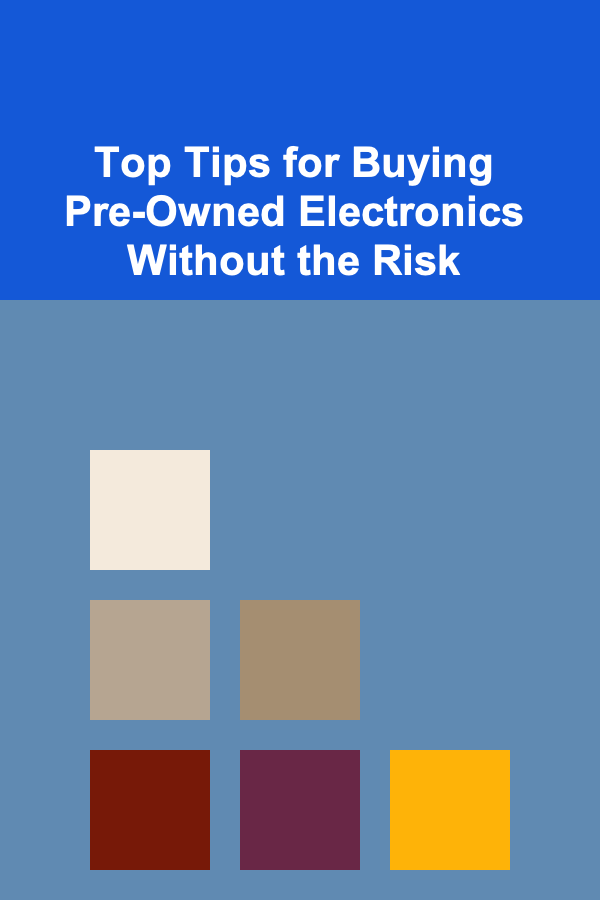
Top Tips for Buying Pre-Owned Electronics Without the Risk
ebook include PDF & Audio bundle (Micro Guide)
$12.99$6.99
Limited Time Offer! Order within the next:

Purchasing pre-owned electronics can be a savvy way to save money while still getting access to high-quality devices. From smartphones and laptops to gaming consoles and cameras, pre-owned electronics can offer excellent value if you know how to navigate the potential risks. However, buying used gadgets does come with a certain degree of risk. The key to making a successful purchase lies in understanding how to mitigate these risks and ensuring you are getting the most for your money.
In this actionable guide, we will explore top tips for buying pre-owned electronics while avoiding common pitfalls. Whether you're looking for a refurbished phone or a second-hand laptop, these strategies will help you make informed, confident decisions.
Understand What You're Buying: New vs. Refurbished vs. Used
Before diving into a purchase, it's important to understand the terminology used to describe pre-owned electronics. This will help you set your expectations and avoid confusion.
- New: The device is brand-new, unused, and typically comes with a full warranty.
- Refurbished: A refurbished device has been returned, repaired, and restored to a like-new condition by the manufacturer or a third-party repair service. These devices often come with warranties, but may have some cosmetic wear.
- Used: A used device is one that has been owned by someone else and is being sold in its current condition. These devices are typically sold "as-is" without any warranty.
Refurbished electronics are generally the safest choice, as they have been tested, repaired, and come with a warranty. If you opt for a used product, be extra cautious about the condition and functionality.
Buy from Reputable Sellers
Where you buy pre-owned electronics is one of the most important factors in reducing your risk. Whether you're buying online or in-person, always opt for a reputable source. Here are some options:
- Manufacturer Refurbished: Many companies, such as Apple, Dell, and Samsung, offer refurbished products directly through their official websites or authorized retailers. These devices are typically tested and come with a warranty, offering more peace of mind.
- Certified Resellers: Look for certified resellers or sellers who specialize in refurbished electronics. Amazon, Best Buy, and eBay have dedicated sections for certified pre-owned devices. These sellers are often subject to quality control and customer service standards.
- Trusted Marketplaces: If you're buying from peer-to-peer platforms like eBay or Craigslist, check the seller's reviews, return policies, and reputation. Look for "Top Rated" sellers on eBay who have a proven track record of successful transactions.
Avoid buying from questionable or unknown sellers, as these purchases can carry significant risk. Always check customer reviews and seller ratings before making a decision.
Inspect the Condition of the Device
When purchasing pre-owned electronics, it's crucial to assess the physical condition of the device thoroughly. This will help you determine if the gadget is truly worth the asking price and if it will function properly for your needs.
- Cosmetic Condition: Check for visible damage, such as scratches, dents, cracks, or discoloration. While some wear and tear is expected, especially in used devices, excessive damage could indicate rough handling or deeper issues.
- Screen Condition: For smartphones, tablets, and laptops, the screen is often the most vulnerable component. Make sure there are no dead pixels, cracks, or significant scratches. A damaged screen can be expensive to replace.
- Ports and Buttons: Inspect all ports (USB, headphone jack, charging port, etc.) to ensure they are functioning. Test buttons and switches to confirm they work smoothly. On a used laptop, check that the keyboard and trackpad are responsive.
- Battery Health: The condition of the battery is critical, especially for devices like smartphones and laptops. If the battery isn't holding a charge or has diminished performance, you may have to replace it soon, which can add to the total cost of ownership.
If possible, test the device in person before purchasing to confirm its functionality. If you're buying online, ask the seller for detailed pictures or videos showcasing the condition of the product.
Check for Manufacturer Warranties and Return Policies
One of the major benefits of purchasing refurbished devices from authorized sellers is the inclusion of warranties. A warranty gives you protection in case the device has hidden defects or malfunctions after purchase. Here's what to look for:
- Manufacturer Warranty: Some refurbished electronics come with a warranty from the original manufacturer. This warranty can vary in length, but it typically covers any defects or malfunctions that arise within a specified period (usually 6 months to 1 year).
- Third-Party Warranty: If the device is not covered by a manufacturer warranty, consider purchasing a third-party warranty for added protection. These warranties can provide coverage for repairs or replacement in case the device fails.
- Return Policy: Always check the return policy before buying a pre-owned product. A flexible return policy allows you to return the device if it doesn't meet your expectations or is defective. Look for sellers that offer at least a 30-day return window.
If the seller doesn't provide a warranty or return policy, be cautious. Without these safeguards, you could be left with a malfunctioning device that cannot be replaced or repaired.
Verify the Authenticity and Serial Numbers
When buying pre-owned electronics, it's essential to verify that the product is authentic and not counterfeit. Counterfeit devices can be poor in quality, and buying them can be a waste of money.
- Check Serial Numbers: Every legitimate electronic device has a unique serial number. You can verify this serial number on the manufacturer's website to ensure the device is genuine and not stolen. For example, Apple allows users to check the warranty status of a device by entering the serial number on their website.
- Verify Model and Specifications: Double-check the model number, specifications, and features to ensure the device matches the description. Sometimes, sellers may list a device incorrectly, or the device might be an older model than advertised.
Be especially careful when purchasing high-demand products like the latest smartphones or gaming consoles. These are often targets for counterfeiters.
Test the Functionality Thoroughly
A device might look good on the outside, but it's equally important to test the internal components and features to ensure they are functioning correctly. If you're buying in-person, do the following:
- Power Up the Device: Make sure the device powers on and operates normally. If it's a smartphone or laptop, check that the operating system loads properly.
- Test the Connectivity: Test Wi-Fi, Bluetooth, and cellular connectivity (for phones) to make sure the device can connect to networks.
- Perform Basic Functions: For smartphones, tablets, and laptops, test the camera, microphone, speakers, and other essential functions. For a used gaming console, make sure the controllers, ports, and games work properly.
If buying online, ask the seller for detailed information about the device's functionality, and request to see a video demonstrating it in use.
Be Aware of Hidden Costs
While pre-owned electronics can save you money, you should factor in potential hidden costs that may arise after the purchase.
- Repairs and Replacements: Some pre-owned devices may require immediate repairs or upgrades, such as a new battery, screen replacement, or software updates. Check the device's condition to avoid surprise costs.
- Accessories: Used devices may not come with original accessories like chargers, cables, or cases. Verify what is included in the sale to avoid having to purchase replacements.
- Software and Security Updates: Some devices, particularly older models, may no longer receive software updates or security patches. This is especially important for smartphones and tablets, as outdated software can leave your device vulnerable to security threats.
Take these potential costs into consideration when evaluating the price of the pre-owned electronics.
Know the Fair Market Value
Before purchasing pre-owned electronics, research the fair market value for the device you are considering. This will help you determine whether the seller's asking price is reasonable. Some tools, such as eBay's sold listings or platforms like Swappa for phones, can help you compare prices for similar items. Keep in mind that heavily discounted products might indicate underlying issues with the device.
If the deal seems too good to be true, it might be worth investigating further. Sometimes, sellers offer pre-owned electronics at an unusually low price because of hidden defects or because the device is outdated.
Conclusion
Buying pre-owned electronics can be a smart way to save money while still acquiring quality devices. However, it comes with risks that must be carefully managed. By choosing reputable sellers, inspecting the condition of the device, verifying authenticity, and checking warranties and return policies, you can minimize the chances of making a bad purchase. Always test the functionality of the device and be aware of any potential hidden costs.
With the right precautions and knowledge, you can confidently shop for pre-owned electronics and enjoy the benefits of high-quality gadgets at a fraction of the price.
Reading More From Our Other Websites
- [Gardening 101] From Pathways to Patios: Creative Lighting Ideas to Transform Any Garden
- [Organization Tip 101] How to Organize Recipes for Batch Cooking
- [Metal Stamping Tip 101] Step‑by‑Step Guide to Precision Titanium Stamping for Aerospace Applications
- [Personal Care Tips 101] How to Use Hair Oil to Soothe an Itchy Scalp and Promote Healthy Hair Growth
- [Personal Investment 101] 5 Proven Ways to Earn Passive Income Using Deep Learning
- [Home Renovating 101] How to Renovate Your Kitchen for Maximum Efficiency
- [Home Holiday Decoration 101] How to Style Your Christmas Tree with Beautiful Decorations That Stand Out
- [Home Storage Solution 101] How to Organize Your Bathroom with Limited Storage
- [Stamp Making Tip 101] From Sketch to Ink: Translating Artwork into Beginner‑Friendly Stamps
- [Home Space Saving 101] How to Store Your Winter Gear Without Taking Up Too Much Room

How to Create a Budget for Expanding Your Antique Collection
Read More
How to Set Up Automated Reminders for Employee Benefits Enrollment: An Actionable Guide
Read More
How to Stage Your Home's Kitchen for a Modern Look
Read More
How to Use Natural Cleaners for Your Appliances
Read More
Top Tips for Minimizing Credit Card Debt Without Sacrificing Your Lifestyle
Read More
10 Tips for Effective Chromatography Techniques
Read MoreOther Products

How to Create a Budget for Expanding Your Antique Collection
Read More
How to Set Up Automated Reminders for Employee Benefits Enrollment: An Actionable Guide
Read More
How to Stage Your Home's Kitchen for a Modern Look
Read More
How to Use Natural Cleaners for Your Appliances
Read More
Top Tips for Minimizing Credit Card Debt Without Sacrificing Your Lifestyle
Read More